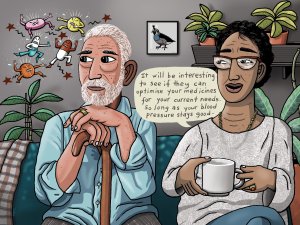For older people and frail people, the long-term benefit of medicines reduces and the potential for harm from adverse effects increases. When the benefit–risk balance changes in this way, medicine review and optimisation are important to simplify the therapeutic regimen, reduce inappropriate medicines and minimise risks. In this article, pharmacist prescriber Linda Bryant uses two case studies to illustrate important considerations during medicine reviews
Tapering opioids for chronic non-cancer pain: Stepping towards a solution
Tapering opioids for chronic non-cancer pain: Stepping towards a solution

Managed withdrawal from opioids taken for chronic non-cancer pain is associated with significant risk, but can be undertaken in primary care if conditions are appropriate
Fiona Cordin and Linda Bryant
Kia ora and welcome to New Zealand Doctor Rata Aotearoa
Not a subscriber? Unlock this article by subscribing here.
1. Busse J, Wang L, Kamaleldin M. Opioids for chronic noncancer pain. A systematic review and meta-analysis. JAMA 2018;320(23):2448–60.
2. Matua Raki. Substance withdrawal management: Guidelines for medical and nursing practitioners. Wellington, NZ: Matua Raki; 2019. https://tinyurl.com/yet2sndu
3. Australian Commission on Safety and Quality in Health Care. Hayes C. Reconsidering opioids. YouTube video, 11 Feb 2021 (25min:39s). www.youtube.com/watch?v=opRUtkiaO9c
4. McPherson S, Smith C, Dobscha S, et al. Changes in pain intensity after discontinuation of long-term opioid therapy for chronic noncancer pain. Pain 2018;159(10):2097–104.
5. Hunter New England Health. Brainman stops his opioids. YouTube video, 7 Oct 2014 (1min:45s). www.youtube.com/watch?v=EFOa7Z7MHHk
6. White R, Hayes C, White S, et al. Using social media to challenge unwarranted clinical variation in the treatment of chronic noncancer pain: the “Brainman” story. J Pain Res 2016;9:701–09.



